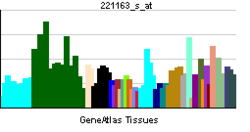- MLXIPL
-
Williams-Beuren syndrome chromosomal region 14 protein is a protein that in humans is encoded by the MLXIPL gene.[1][2] The protein is also known as Carbohydrate Response Element Binding Protein for its interaction with carbohydrate response element sequences of DNA.
This gene encodes a basic helix-loop-helix leucine zipper transcription factor of the Myc/Max/Mad superfamily. This protein forms a heterodimeric complex and binds and activates, in a glucose-dependent manner, carbohydrate response element (ChoRE) motifs in the promoters of triglyceride synthesis genes. The gene is deleted in Williams-Beuren syndrome, a multisystem developmental disorder caused by the deletion of contiguous genes at chromosome 7q11.23.[2]
Contents
Interactions
MLXIPL has been shown to interact with MLX.[3]
Role in Glycolysis
ChREBP is translocated to the nucleus and binds to DNA after dephosphorylation of a p-Ser and a p-Thr residue by PP2A, which itself is activated by Xylulose-5-phosphate. Xu5p is produced in the pentose phosphate pathway when levels of Glucose-6-phosphate are high (the cell has ample glucose). In the liver, ChREBP mediates activation of several regulatory enzymes of glycolysis and lipogenesis including L-type pyruvate kinase (L-PK), acetyl CoA carboxylase, and fatty acid synthase.
References
- ^ Meng X, Lu X, Li Z, Green ED, Massa H, Trask BJ, Morris CA, Keating MT (Jan 1999). "Complete physical map of the common deletion region in Williams syndrome and identification and characterization of three novel genes". Hum Genet 103 (5): 590–9. doi:10.1007/s004390050874. PMID 9860302.
- ^ a b "Entrez Gene: MLXIPL MLX interacting protein-like". http://www.ncbi.nlm.nih.gov/sites/entrez?Db=gene&Cmd=ShowDetailView&TermToSearch=51085.
- ^ Cairo, S; Merla G, Urbinati F, Ballabio A, Reymond A (Mar. 2001). "WBSCR14, a gene mapping to the Williams--Beuren syndrome deleted region, is a new member of the Mlx transcription factor network". Hum. Mol. Genet. (England) 10 (6): 617–27. doi:10.1093/hmg/10.6.617. ISSN 0964-6906. PMID 11230181.
Further reading
- de Luis O, Valero MC, Jurado LA (2000). "WBSCR14, a putative transcription factor gene deleted in Williams-Beuren syndrome: complete characterisation of the human gene and the mouse ortholog.". Eur. J. Hum. Genet. 8 (3): 215–22. doi:10.1038/sj.ejhg.5200435. PMID 10780788.
- Cairo S, Merla G, Urbinati F, et al. (2001). "WBSCR14, a gene mapping to the Williams--Beuren syndrome deleted region, is a new member of the Mlx transcription factor network.". Hum. Mol. Genet. 10 (6): 617–27. doi:10.1093/hmg/10.6.617. PMID 11230181.
- Kawaguchi T, Takenoshita M, Kabashima T, Uyeda K (2002). "Glucose and cAMP regulate the L-type pyruvate kinase gene by phosphorylation/dephosphorylation of the carbohydrate response element binding protein.". Proc. Natl. Acad. Sci. U.S.A. 98 (24): 13710–5. doi:10.1073/pnas.231370798. PMC 61106. PMID 11698644. http://www.pubmedcentral.nih.gov/articlerender.fcgi?tool=pmcentrez&artid=61106.
- Kawaguchi T, Osatomi K, Yamashita H, et al. (2002). "Mechanism for fatty acid "sparing" effect on glucose-induced transcription: regulation of carbohydrate-responsive element-binding protein by AMP-activated protein kinase.". J. Biol. Chem. 277 (6): 3829–35. doi:10.1074/jbc.M107895200. PMID 11724780.
- Strausberg RL, Feingold EA, Grouse LH, et al. (2003). "Generation and initial analysis of more than 15,000 full-length human and mouse cDNA sequences.". Proc. Natl. Acad. Sci. U.S.A. 99 (26): 16899–903. doi:10.1073/pnas.242603899. PMC 139241. PMID 12477932. http://www.pubmedcentral.nih.gov/articlerender.fcgi?tool=pmcentrez&artid=139241.
- Ota T, Suzuki Y, Nishikawa T, et al. (2004). "Complete sequencing and characterization of 21,243 full-length human cDNAs.". Nat. Genet. 36 (1): 40–5. doi:10.1038/ng1285. PMID 14702039.
- Hillman RT, Green RE, Brenner SE (2005). "An unappreciated role for RNA surveillance.". Genome Biol. 5 (2): R8. doi:10.1186/gb-2004-5-2-r8. PMC 395752. PMID 14759258. http://www.pubmedcentral.nih.gov/articlerender.fcgi?tool=pmcentrez&artid=395752.
- Merla G, Howald C, Antonarakis SE, Reymond A (2005). "The subcellular localization of the ChoRE-binding protein, encoded by the Williams-Beuren syndrome critical region gene 14, is regulated by 14-3-3.". Hum. Mol. Genet. 13 (14): 1505–14. doi:10.1093/hmg/ddh163. PMID 15163635.
- Gerhard DS, Wagner L, Feingold EA, et al. (2004). "The status, quality, and expansion of the NIH full-length cDNA project: the Mammalian Gene Collection (MGC).". Genome Res. 14 (10B): 2121–7. doi:10.1101/gr.2596504. PMC 528928. PMID 15489334. http://www.pubmedcentral.nih.gov/articlerender.fcgi?tool=pmcentrez&artid=528928.
- Li MV, Chang B, Imamura M, et al. (2006). "Glucose-dependent transcriptional regulation by an evolutionarily conserved glucose-sensing module.". Diabetes 55 (5): 1179–89. doi:10.2337/db05-0822. PMID 16644671.
Categories:- Human proteins
- Chromosome 7 gene stubs
Wikimedia Foundation. 2010.

